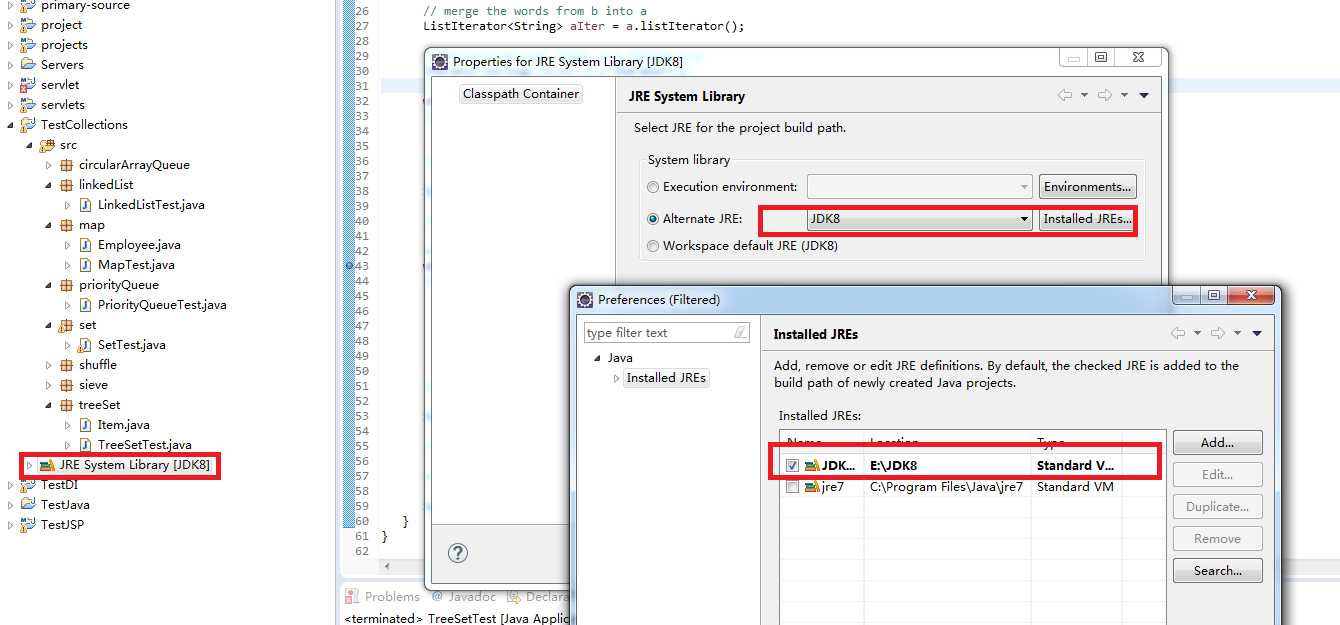标签:
一生二,二生三,三生万物,基础永远是一个计算机人的立身之本,相信看到这篇文章的人一般都知道数据结构这门课程,要不也不会找到我的这篇文章。数据结构这门课程的分析奠定了工程师对各种平台中的容器类,集合类的理解基础,正如好多人所说的,如果你对某个平台的集合类理解的不透彻,很可能,你并不是不会使用那个平台上的代码,而是数据结构没理解透彻。
Windows NT平台上,MFC, ATL提供的集合类很少,而且功能很弱,这就导致了事实上的标准成了STL,相比于.Net 和 Java平台 STL在使用上稍显逊色,但是效率上应该是更胜一筹。但是不管哪种实现,都是基于数据结构的理论基础的,本文将讨论的是Java平台的高频集合类的使用方法。
首先要讨论的是LinkedList, 当我们需要经常性的插入或者删除元素的时候,我们的选择是LinkedList,因为没有移动元素的开销,但是Java中的LinkedList有一个怪癖,大家可能需要注意一下,每当需要删除元素的时候,需要先调用一次迭代器的next(), 然后是remove(), 使用起来稍显不自然。
public class LinkedListTest { public static void main(String[] args) { List<String> a = new LinkedList<>(); a.add("Amy"); a.add("Carl"); a.add("Erica"); List<String> b = new LinkedList<>(); b.add("Bob"); b.add("Doug"); b.add("Frances"); b.add("Gloria"); // merge the words from b into a ListIterator<String> aIter = a.listIterator(); //Iterator<String> aIter = a.iterator(); Iterator<String> bIter = b.iterator(); while (bIter.hasNext()) { if (aIter.hasNext()) aIter.next(); aIter.add(bIter.next()); } System.out.println(a); // remove every second word from b bIter = b.iterator(); while (bIter.hasNext()) { bIter.next(); // skip one element if (bIter.hasNext()) { bIter.next(); // skip next element bIter.remove(); // remove that element } } System.out.println(b); // bulk operation: remove all words in b from a a.removeAll(b); System.out.println(a); } }
LinkedList在对数据进行查找的时候,时间复杂度是O(n)的,当对查找需求比较高的时候就需要使用更加高效率的容器,比如HashSet, 其对元素的查找可以达到线性时间复杂度。
public class SetTest { public static void main(String[] args) { Set<String> words = new HashSet<String>(); // HashSet implements Set long totalTime = 0; Scanner in = new Scanner(System.in); while (in.hasNext()) { String word = in.next(); long callTime = System.currentTimeMillis(); words.add(word); callTime = System.currentTimeMillis() - callTime; totalTime += callTime; } Iterator<String> iter = words.iterator(); for (int i = 1; i <= 20 && iter.hasNext(); i++) System.out.println(iter.next()); System.out.println(". . ."); System.out.println(words.size() + " distinct words. " + totalTime + " milliseconds."); } }
HashSet对元素的迭代访问是随机顺序的,所以如果对顺序比较敏感,可能就要考虑TreeSet,插入后的元素自动排序,输出时是有序的集合。
public class TreeSetTest { public static void main(String[] args) { SortedSet<Item> parts = new TreeSet<>(); parts.add(new Item("Toaster", 1234)); parts.add(new Item("Widget", 4562)); parts.add(new Item("Modem", 9912)); System.out.println(parts); SortedSet<Item> sortByDescription = new TreeSet<>(new Comparator<Item>() { public int compare(Item a, Item b) { String descrA = a.getDescription(); String descrB = b.getDescription(); return descrA.compareTo(descrB); } }); sortByDescription.addAll(parts); System.out.println(sortByDescription); } }
还记得数据结构中的小根堆吧?Java中也有相应的实现,他的名字是priorityQueue, 这个小根堆本身的迭代是无序的,但是小根堆保证每次删除的元素都是集合中最小的一个,也就是根。
public class PriorityQueueTest { public static void main(String[] args) { PriorityQueue<GregorianCalendar> pq = new PriorityQueue<>(); pq.add(new GregorianCalendar(1906, Calendar.DECEMBER, 9)); // G. Hopper pq.add(new GregorianCalendar(1815, Calendar.DECEMBER, 10)); // A. Lovelace pq.add(new GregorianCalendar(1903, Calendar.DECEMBER, 3)); // J. von Neumann pq.add(new GregorianCalendar(1910, Calendar.JUNE, 22)); // K. Zuse System.out.println("Iterating over elements..."); for (GregorianCalendar date : pq) System.out.println(date.get(Calendar.YEAR)); System.out.println("Removing elements..."); while (!pq.isEmpty()) System.out.println(pq.remove().get(Calendar.YEAR)); } }
大家在使用Set类集合的时候有个不方便的地方就是,如果我需要查找一个元素,我得先知道这个元素的详细信息,所有的信息,而不能通过关键字查找,Map的出现解决了这个问题, Map本身是一个键值对,可以通过键来取值,这就大大方便了查找,但是付出的代价是多存储了一个键。
public class MapTest { public static void main(String[] args) { Map<String, Employee> staff = new HashMap<>(); staff.put("144-25-5464", new Employee("Amy Lee")); staff.put("567-24-2546", new Employee("Harry Hacker")); staff.put("157-62-7935", new Employee("Gary Cooper")); staff.put("456-62-5527", new Employee("Francesca Cruz")); // print all entries System.out.println(staff); // remove an entry staff.remove("567-24-2546"); // replace an entry staff.put("456-62-5527", new Employee("Francesca Miller")); // look up a value System.out.println(staff.get("157-62-7935")); // iterate through all entries for (Map.Entry<String, Employee> entry : staff.entrySet()) { String key = entry.getKey(); Employee value = entry.getValue(); System.out.println("key=" + key + ", value=" + value); } } }
另外,Java语言本身是开源的,所有这些集合类的实现也是开源的,如果我们能够学习和调试这些大师们写的代码,无疑会使我们的学习事半功倍,那么怎么进行设置才能调试这些平台源码呢?
1. 必须安装JDK, JRE是不行的
2. 在配置项目的时候选择JDK下的JRE
3. 在你想研究的类或者函数上按键F3, 更多快捷键请参考下文, 具体设置请参看下图。
http://www.cnblogs.com/pugang/p/4471558.html

Java开发中的高频Collections用法总结与Java平台实现源代码查看方式
标签:
原文地址:http://www.cnblogs.com/pugang/p/4471661.html